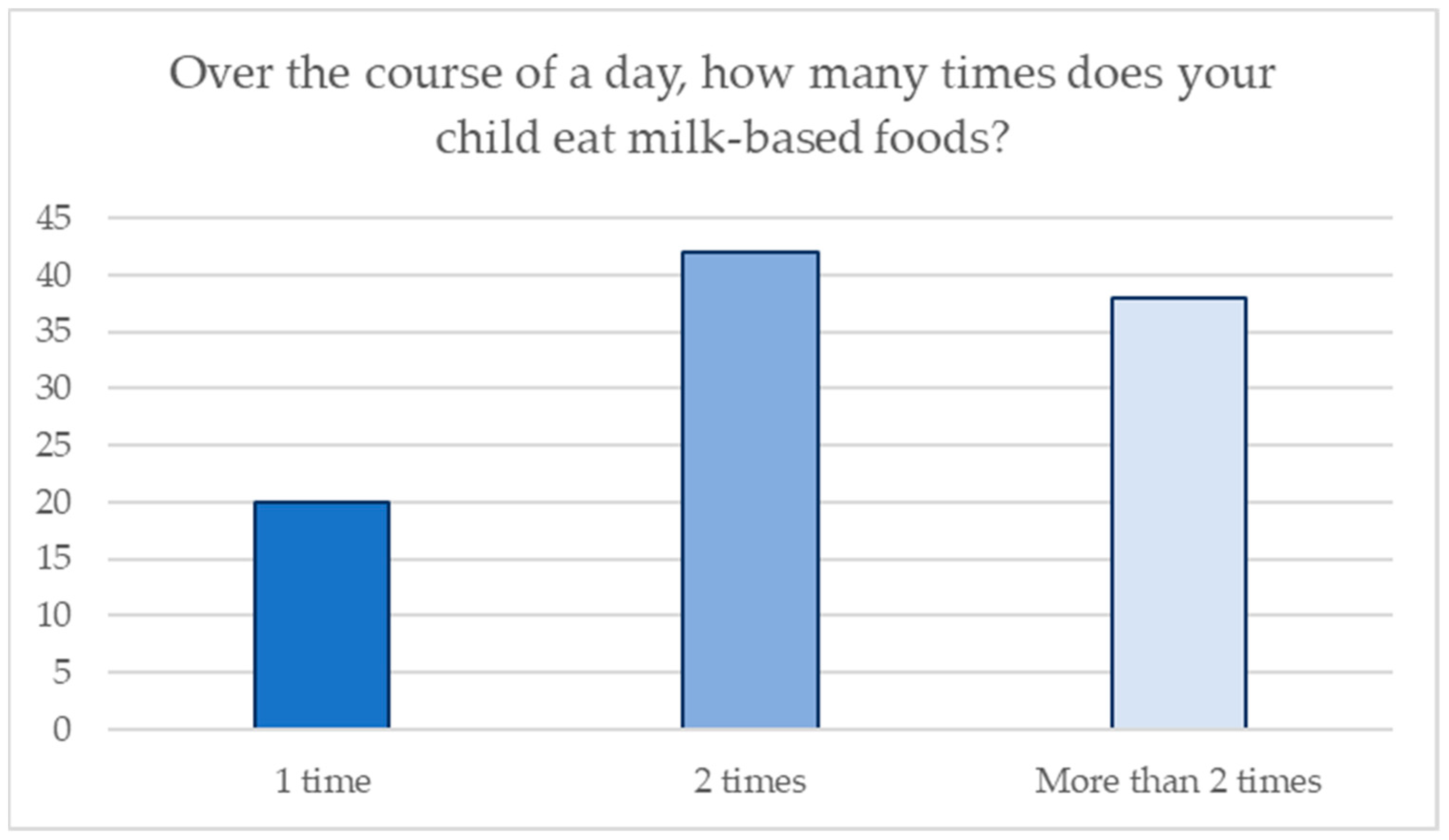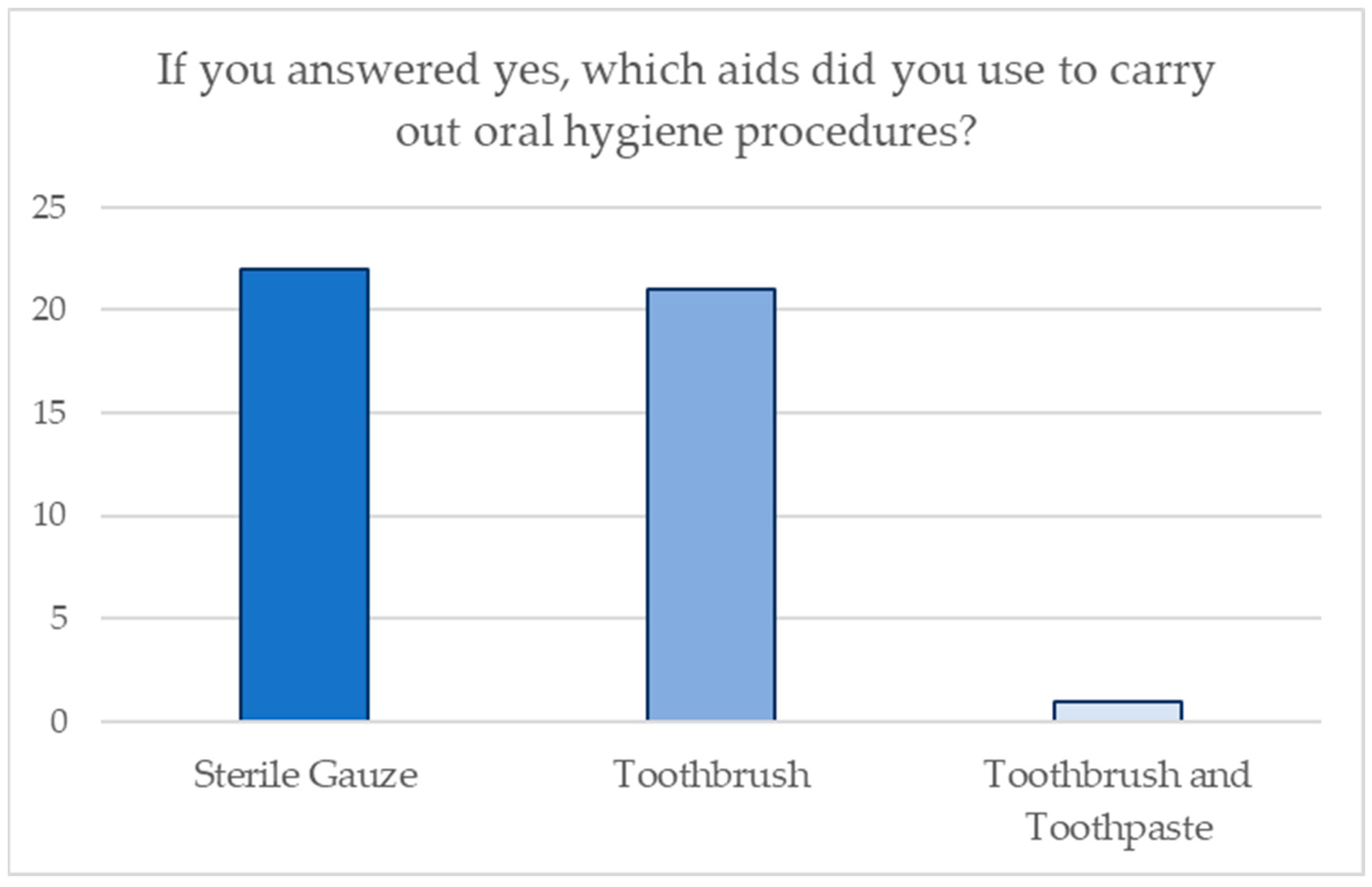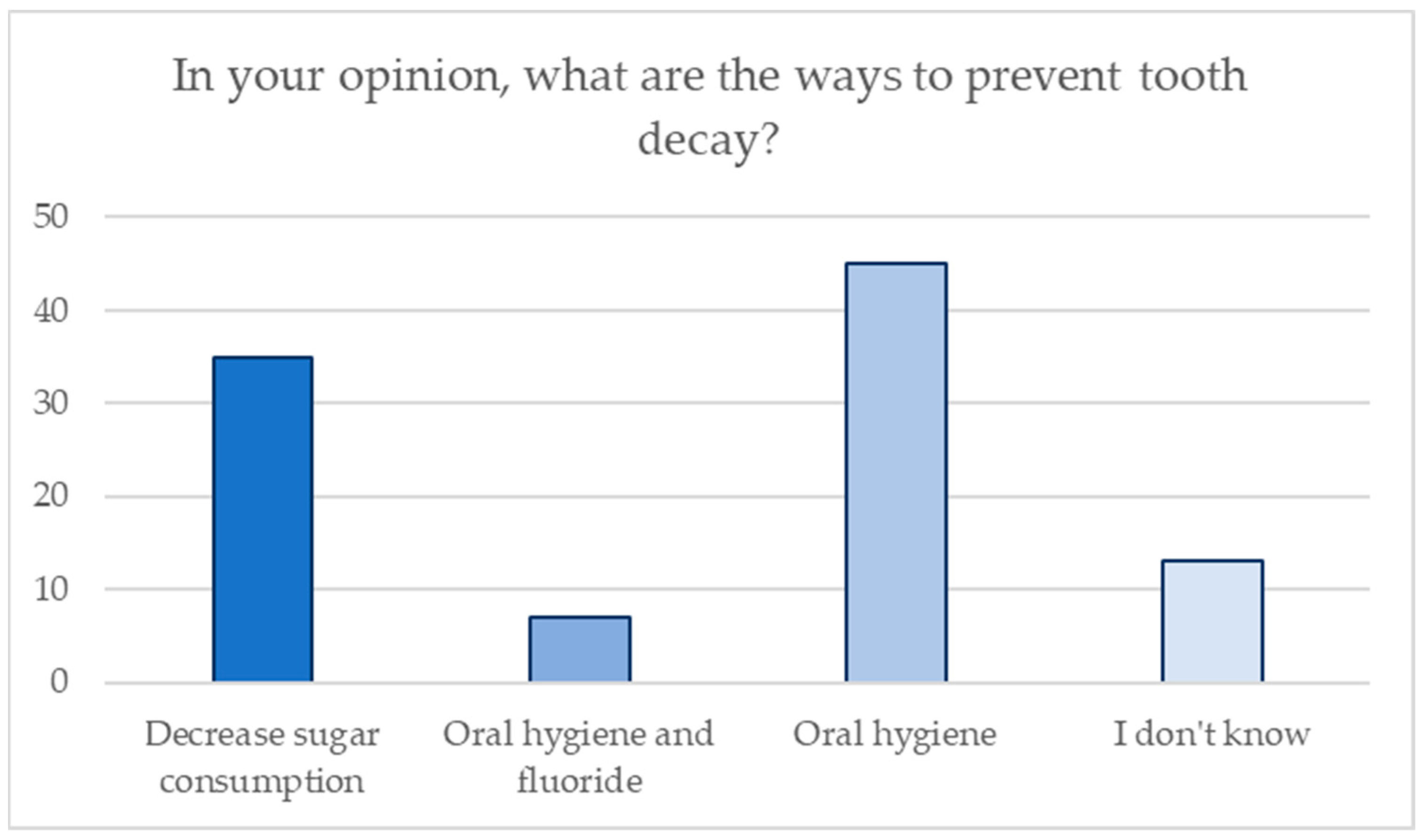Parental Knowledge and Its Impact on Nutrition and Oral Health Habits in Children: A Cognitive Investigation
Abstract
1. Introduction
2. Materials and Methods
3. Results
4. Discussion
5. Conclusions
Author Contributions
Funding
Institutional Review Board Statement
Informed Consent Statement
Data Availability Statement
Conflicts of Interest
References
- World Health Organization. European Food and Nutrition Action Plan 2015–2020; World Health Organization: Geneva, Switzerland, 2015. [Google Scholar]
- Mensink, F.; Schwinghammer, S.A.; Smeets, A. The Healthy School Canteen programme: A promising intervention to make the school food environment healthier. J. Environ. Public Health 2012, 2012, 415746. [Google Scholar] [CrossRef] [PubMed]
- Chen, X.X.; Xia, B.; Ge, L.H.; Yuan, J.W. Beijing da xue xue bao. Yi Xue Ban J. Peking University. Health Sci. 2016, 48, 1060–1066. [Google Scholar]
- Chong, C.Y.L.; Bloomfield, F.H.; O’Sullivan, J.M. Factors Affecting Gastrointestinal Microbiome Development in Neonates. Nutrients 2018, 10, 274. [Google Scholar] [CrossRef] [PubMed]
- Venter, C.; Pereira, B.; Voigt, K.; Grundy, J.; Clayton, C.B.; Higgins, B.; Arshad, S.H.; Dean, T. Factors associated with maternal dietary intake, feeding and weaning practices, and the development of food hypersensitivity in the infant. Pediatr. Allergy Immunol. 2009, 20, 320–327. [Google Scholar] [CrossRef] [PubMed]
- Mahoney, P. Dental fast track: Prenatal enamel growth, incisor eruption and weaning in human infants. Am. J. Phys. Anthropol. 2015, 156, 407–421. [Google Scholar] [CrossRef] [PubMed]
- Herndon, J.B.; Tomar, S.L.; Lossius, M.N.; Catalanotto, F.A. Preventive oral health care in early childhood: Knowledge, confidence, and practices of pediatricians and family physicians in Florida. J. Pediatr. 2010, 157, 1018–1024. [Google Scholar] [CrossRef] [PubMed]
- Wagner, Y.; Heinrich-Weltzien, R. Pediatricians’ oral health recommendations for 0- to 3-year-old children: Results of a survey in Thuringia, Germany. BMC Oral Health 2014, 14, 44. [Google Scholar] [CrossRef] [PubMed][Green Version]
- Toumba, K.J.; Twetman, S.; Splieth, C.; Parnell, C.; van Loveren, C.; Lygidakis, N.A. Guidelines on the use of fluoride for caries prevention in children: An updated EAPD policy document. Eur. Arch. Paediatr. Dent. 2019, 20, 507–516. [Google Scholar] [CrossRef] [PubMed]
- Straccamore, L. Experimental Study on the Correlation between Developmental Nutrition and Oral Health. Master’s Thesis, Sapienza University of Rome, Rome, Italy, 2019. [Google Scholar]
- Cogulu, D.; Saglam, C. Genetic aspects of dental caries. Front. Dent. Med. 2022, 3, 1060177. [Google Scholar] [CrossRef]
- Petersen, P.E.; Bourgeois, D.; Ogawa, H.; Estupinan-Day, S.; Ndiaye, C. The global burden of oral diseases and risks to oral health. Bull. World Health Organ. 2005, 83, 661–669. [Google Scholar] [PubMed]
- Renuka, P.; Pushpanjali, K.; Sangeetha, R. Review on “Influence of host genes on dental caries”. IOSR J. Dent. Med. Sci. 2013, 4, 86–92. [Google Scholar] [CrossRef]
- Slayton, R.L.; Cooper, M.E.; Marazita, M. Tuftelin, mutans streptococci, and dental caries susceptibility. J. Dent. Res. 2005, 84, 711–714. [Google Scholar] [CrossRef] [PubMed]
- Harris, N.O.; Garcia-Godoy, F. Primary Preventive Dentistry, 6th ed.; Julie Levin Alexander: Upper Saddle River, NJ, USA, 2004; p. 337. [Google Scholar]
- Polimeni, A. Odontoiatria Pediatrica, 2nd ed.; Edra: Rome, Italy, 2019. [Google Scholar]
- Anil, S.; Anand, P.S. Early Childhood Caries: Prevalence, Risk Factors, and Prevention. Front. Pediatr. 2017, 5, 157. [Google Scholar] [CrossRef] [PubMed]
- Peres, K.G.; Nascimento, G.G.; Peres, M.A.; Mittinty, M.N.; Demarco, F.F.; Santos, I.S.; Matijasevich, A.; Barros, A.J.D. Impact of Prolonged Breastfeeding on Dental Caries: A Population-Based Birth Cohort Study. Pediatrics 2017, 140, e20162943. [Google Scholar] [CrossRef] [PubMed]
- Tham, R.; Bowatte, G.; Dharmage, S.; Tan, D.; Lau, M.; Dai, X.; Allen, K.; Lodge, C. Breastfeeding and the risk of dental caries: A systematic review and meta-analysis. Acta Paediatr. 2015, 104, 62–84. [Google Scholar] [CrossRef] [PubMed]
- World Health Organization. Guideline: Sugars Intake for Adults and Children; World Health Organization: Geneva, Switzerland, 2015. [Google Scholar]
- Chaffee, B.W.; Feldens, C.A.; Rodrigues, P.H.; Vitolo, M.R. Feeding practices in infancy associated with caries incidence in early childhood. Community Dent. Oral Epidemiol. 2015, 68, 113–121. [Google Scholar] [CrossRef] [PubMed]
- Feldens, C.A.; Rodrigues, P.H.; De Anastacio, G.; Vitolo, M.R.; Chaffee, B.W. Feeding frequency in infancy and dental caries in childhood: A prospective cohort study. Int. Dent. J. 2018, 68, 113–121. [Google Scholar] [CrossRef] [PubMed]
- Wagner, Y.; Heinrich-Weltzien, R. Risk factors for dental problems: Recommendations for oral health in infancy. Early Hum. Dev. 2017, 114, 16–21. [Google Scholar] [CrossRef] [PubMed]
- World Health Organization. Global Oral Health Status Report: Towards Universal Health Coverage for Oral Health by 2030. Regional Summary of the African Region; World Health Organization: Geneva, Switzerland, 2023. [Google Scholar]
- Everett, E.T. Fluoride’s effects on the formation of teeth and bones, and the influence of genetics. J. Dent. Res. 2011, 90, 552–560. [Google Scholar] [CrossRef] [PubMed] [PubMed Central]




| Question | N | % |
|---|---|---|
| 1. How old is your baby (months)? | ||
| 4 | 1 | 1 |
| 5 | 3 | 3 |
| 6 | 17 | 17 |
| 7 | 7 | 7 |
| 8 | 7 | 7 |
| 9 | 3 | 3 |
| 10 | 3 | 3 |
| 11 | 4 | 4 |
| 12 | 11 | 11 |
| 13 | 1 | 1 |
| 14 | 2 | 2 |
| 15 | 4 | 4 |
| 16 | 2 | 2 |
| 17 | 1 | 1 |
| 18 | 2 | 2 |
| 19 | 2 | 2 |
| 20 | 4 | 4 |
| 21 | 2 | 2 |
| 22 | 4 | 4 |
| 23 | 6 | 6 |
| 24 | 14 | 14 |
| 2. Do you work outside the home? | ||
| Yes, I’m working full time | 23 | 23 |
| Yes, I’m working part time | 21 | 21 |
| No, I’m not working | 56 | 56 |
| 3. Did you breastfeed your baby? | ||
| Yes, I did | 57 | 57 |
| Yes, less than a month | 31 | 31 |
| No, I didn’t | 12 | 12 |
| 4. If Yes, how long was the period of breastfeeding (months)? | ||
| 1 | 2 | 2 |
| 2 | 2 | 2 |
| 3 | 10 | 10 |
| 4 | 5 | 5 |
| 5 | 6 | 6 |
| 6 | 12 | 12 |
| 7 | 1 | 1 |
| 8 | 2 | 2 |
| 9 | 4 | 4 |
| 10 | 4 | 4 |
| 11 | 1 | 1 |
| 12 | 2 | 2 |
| 13 | 0 | 0 |
| 14 | 1 | 1 |
| 15 | 1 | 1 |
| 16 | 1 | 1 |
| 17 | 0 | 0 |
| 18 | 2 | 2 |
| 19 | 1 | 1 |
| 5. At what month did weaning start? | ||
| 0–4 months | 21 | 21 |
| 5–7 months | 78 | 78 |
| 8–10 months | 1 | 1 |
| Over the 10 months | 0 | 0 |
| 6. What foods do you prefer to feed your baby? | ||
| Ready-to-eat baby food | 5 | 5 |
| Freeze-dried baby food | 2 | 2 |
| Homogenized baby food | 47 | 47 |
| Smoothies | 14 | 14 |
| Other | 32 | 32 |
| 7. Which baby foods do you use? | ||
| Commercial homogenized baby food | 47 | 47 |
| Homemade homogenized baby food | 57 | 57 |
| 8. In a typical week, how many times does your child eat fruit puree? | ||
| Less than 3 times | 11 | 11 |
| 3 times | 25 | 25 |
| 6 times | 6 | 6 |
| More than 6 times | 48 | 48 |
| 9. In a typical week, how many times does your child eat homogenized meat or fish baby food or rice cream? | ||
| Less than 3 times | 14 | 14 |
| 3 times | 27 | 27 |
| 6 times | 15 | 15 |
| More than 6 times | 44 | 44 |
| 10. Over the course of a day, how many times does your child eat milk-based foods? | ||
| 1 time | 20 | 20 |
| 2 times | 42 | 42 |
| More than 2 times | 38 | 38 |
| 11. Do you add biscuits to milk-based baby food? | ||
| Yes, I do | 68 | 68 |
| No, I don’t | 32 | 32 |
| 12. When did the first (milk) tooth erupt? | ||
| 3–5 months | 13 | 13 |
| 6–8 months | 48 | 48 |
| 9–12 months | 15 | 15 |
| Over the 12 months | 1 | 1 |
| It has not yet erupted | 1 | 1 |
| 13. Did you perform oral hygiene procedures in the first months of your baby’s life? | ||
| Yes, I did | 32 | 32 |
| No, I didn’t | 68 | 68 |
| 14. If you answered Yes, what aids did you use to carry out oral hygiene procedures? | ||
| Sterile gauze | 22 | 22 |
| Toothbrush | 21 | 21 |
| Toothbrush and toothpaste | 44 | 44 |
| 15. Did you use gauze and/or cloth or rubber gloves specifically for your child’s home oral hygiene? | ||
| Yes, I did | 24 | 24 |
| No, I didn’t | 76 | 76 |
| 16. Does your child receive fluoride supplements? | ||
| Yes, he does | 23 | 23 |
| No, he doesn’t | 77 | 77 |
| 17. If you answered Yes, which ones? | ||
| Pediafluor | 6 | 6 |
| Fluormil | 4 | 4 |
| Defluor | 0 | 0 |
| Other | 6 | 6 |
| 18. If you answered Yes, how often? | ||
| Once or more times a day | 14 | 14 |
| 2 or 3 times a week | 5 | 5 |
| Once a week | 2 | 2 |
| Rarely | 2 | 2 |
| 19. Do you think the fluoride supplements are necessary? | ||
| Yes | 27 | 27 |
| No | 73 | 73 |
| 20. In your opinion, in what age group should fluoride toothpaste be introduced? | ||
| 1 year | 19 | 19 |
| 2 years | 42 | 42 |
| 3 years | 30 | 30 |
| 4 years | 2 | 2 |
| Over 4 years | 7 | 7 |
| 21. Do you think that a healthy diet can satisfy the fluoride intake in relation to the age of your child? | ||
| Yes | 83 | 83 |
| No | 17 | 17 |
| 22. Does the type of drinking water you usually use at home depend on the amount of fluoride contained in it? | ||
| Yes | 37 | 37 |
| No | 63 | 63 |
| 23. Do you use any added sugars in your baby’s diet? | ||
| No, I don’t | 73 | 73 |
| Yes, I use sucrose | 2 | 2 |
| Yes, I use honey | 19 | 19 |
| Yes, I use fructose | 4 | 4 |
| Yes, I use artificial sweeteners | 2 | 2 |
| Yes, I use natural sweeteners | 0 | 0 |
| 24. If you answered Yes, how often? | ||
| Frequently | 3 | 3 |
| As needed/if necessary | 8 | 8 |
| Rarely | 10 | 10 |
| 25. Does the type of baby foods for your child depend on its price? | ||
| Yes | 10 | 10 |
| No | 90 | 90 |
| 26. Do you carefully read the label of baby food products? | ||
| Yes | 74 | 74 |
| No | 26 | 26 |
| 27. Did you notice if in homogenized meat baby food or homogenized fish baby food there are also sugars? | ||
| Yes | 34 | 34 |
| No | 66 | 66 |
| 28. If your baby cries, do you think he or she is hungry? | ||
| Yes | 36 | 36 |
| No | 64 | 64 |
| 29. In your opinion, is the behavior of dipping the pacifier in honey a useful practice? | ||
| Yes | 10 | 10 |
| No | 90 | 90 |
| 30. Do you use sugar-sweetened beverages to put your baby to sleep? | ||
| Yes | 1 | 1 |
| Sometimes | 7 | 7 |
| No | 92 | 92 |
| 31. To what extent do you think your child’s primary dentition can influence the permanent dentition? | ||
| Very much | 51 | 51 |
| Somewhat | 33 | 33 |
| A little bit | 16 | 16 |
| Not relevant | 0 | 0 |
| 32. If your child eats too much sugar, do you know the complications? | ||
| Yes | 93 | 93 |
| No | 7 | 7 |
| 33. In your opinion, what are the ways to prevent tooth decay? | ||
| Decrease sugar consumption | 35 | 35 |
| Oral hygiene and fluoride | 7 | 7 |
| Oral hygiene | 45 | 45 |
| I don’t know | 13 | 13 |
| 34. Do you think prolonged breastfeeding (over 2 years) is harmful for your child? | ||
| Yes | 32 | 32 |
| No | 68 | 68 |
| 35. Do you think a dental visit before the age of 6 is useful for your child? | ||
| Yes | 84 | 84 |
| No | 16 | 16 |
Disclaimer/Publisher’s Note: The statements, opinions and data contained in all publications are solely those of the individual author(s) and contributor(s) and not of MDPI and/or the editor(s). MDPI and/or the editor(s) disclaim responsibility for any injury to people or property resulting from any ideas, methods, instructions or products referred to in the content. |
© 2024 by the authors. Licensee MDPI, Basel, Switzerland. This article is an open access article distributed under the terms and conditions of the Creative Commons Attribution (CC BY) license (https://creativecommons.org/licenses/by/4.0/).
Share and Cite
Guerra, F.; Zumbo, G.; Straccamore, L.; Sansotta, L.; Stamegna, C.; Iacono, R.; Corridore, D.; Vozza, I. Parental Knowledge and Its Impact on Nutrition and Oral Health Habits in Children: A Cognitive Investigation. J. Clin. Med. 2024, 13, 5631. https://doi.org/10.3390/jcm13185631
Guerra F, Zumbo G, Straccamore L, Sansotta L, Stamegna C, Iacono R, Corridore D, Vozza I. Parental Knowledge and Its Impact on Nutrition and Oral Health Habits in Children: A Cognitive Investigation. Journal of Clinical Medicine. 2024; 13(18):5631. https://doi.org/10.3390/jcm13185631
Chicago/Turabian StyleGuerra, Fabrizio, Giulia Zumbo, Lucia Straccamore, Laura Sansotta, Claudio Stamegna, Roberta Iacono, Denise Corridore, and Iole Vozza. 2024. "Parental Knowledge and Its Impact on Nutrition and Oral Health Habits in Children: A Cognitive Investigation" Journal of Clinical Medicine 13, no. 18: 5631. https://doi.org/10.3390/jcm13185631
APA StyleGuerra, F., Zumbo, G., Straccamore, L., Sansotta, L., Stamegna, C., Iacono, R., Corridore, D., & Vozza, I. (2024). Parental Knowledge and Its Impact on Nutrition and Oral Health Habits in Children: A Cognitive Investigation. Journal of Clinical Medicine, 13(18), 5631. https://doi.org/10.3390/jcm13185631










